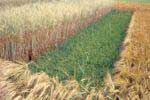 |
Cereals and legumes
The main objective of this project is to increase the production of organic cereals and legumes. Most emphasis is placed on improving the efficiency of cropping systems at the field level, tillage strategies in rotations, and studies to examine the significance of increased proportions of cereals and legumes in rotations. The project incorporates several sub-projects, characterised under four main headings: 1) the management of weeds, pathogens and pests, 2) crop nutrition, 3) the choice of crop and cultivar in relation to quality, and 4) cropping systems with emphasis on cereals and legumes.
With regard to weeds, the studies examine the possibilities of: a) direct weed control in undersown cereal crops, b) exploiting the positive interactions between weed control and the improved supply of nutrients by slurry placement, and c) developing control strategies directed at individual fields or the whole rotation.
In the case of plant diseases, the investigations concentrate on two seed-borne infections: common bunt in wheat and flag smut in rye. Direct control with seed dressings based on plant extracts is being examined with winter wheat and rye, and different wheat cultivars are being screened for resistance to common bunt.
With regard to pests, the research concentrates on the black bean aphid that attacks faba beans. In this case investigations are under way to find varieties that are a poor host to these aphids.
Concerning crop nutrients, in relation to potassium the project examines the significance for the yield of organic cereals and legumes of soil type and nutrient status, leaching, and nutrient balance. Laboratory methods to examine the ability of organic soils to satisfy crops requirements for potassium are also being tested, as is the availability to crops of the potassium in different fertilisers.
Regarding the choice of crop and cultivar for quality, the study examines nutritional options and antioxidants. The latter are thought to have a number of positive effects on human health and to have significance for the plant's ability to fight off fungal attacks. The project focuses on lupins, naked oats and spring barley. At the rotation level it examines how, with different soil types and fertiliser levels, increasing amounts of cereals and legumes in the rotation influence yield, quality, and N, P and K balances, as well as the incidence of weeds, infections and pests.
Summary
Publications
Project title
II.4 Cereals and legumes
Project leader
Ilse A. Rasmussen, Danish Institute of Agricultural Science, Department for Plant Protection,
Research Centre Flakkebjerg, DK 4200 Slagelse
Tel: +45 5358 6300, Fax: +45 5358 6371
E-mail: IlseA.Rasmussen@agrsci.dk
Project participants
Rikke Klith Jensen, Lars Monrad Hansen, Johannes Ravn Jørgensen, Bent J. Nielsen, Karsten Rasmussen, Kirsten Brandt, and Rilkke Nørbæk, Danish Institute of Agricultural Science
Anders Borgen, Bjarne Jørnsgaard and Jacob Weiner, The Royal Veterinary and Agricultural University
Hanne Østergaard, Risø National Laboratory
|